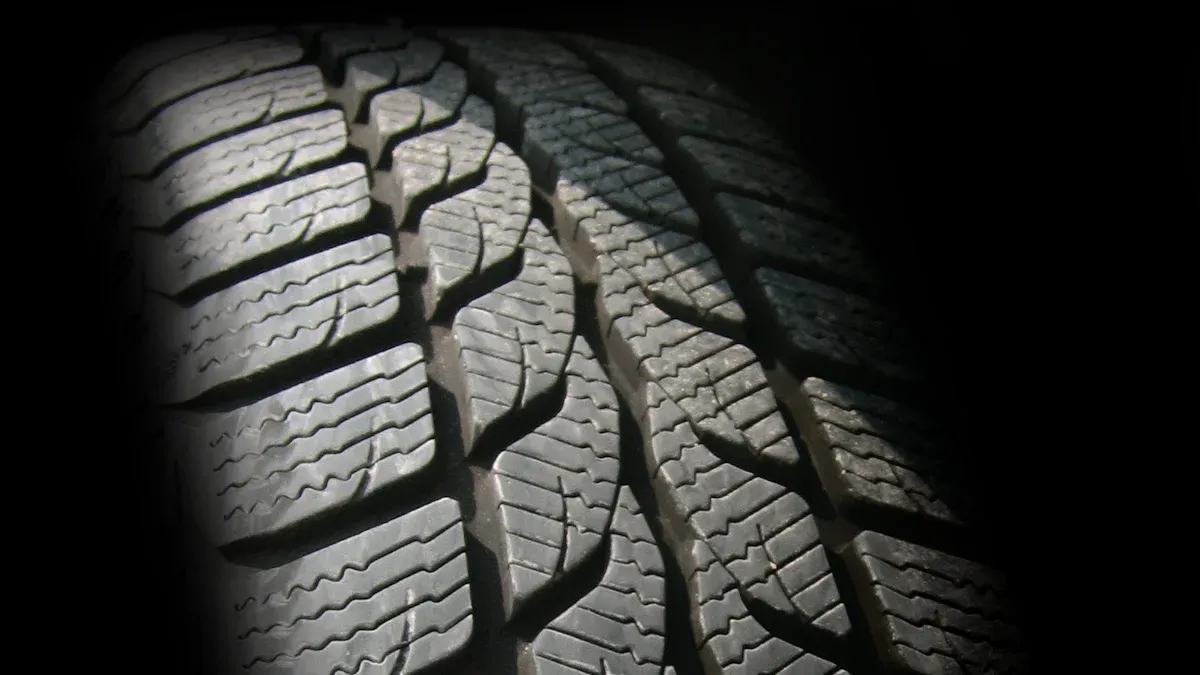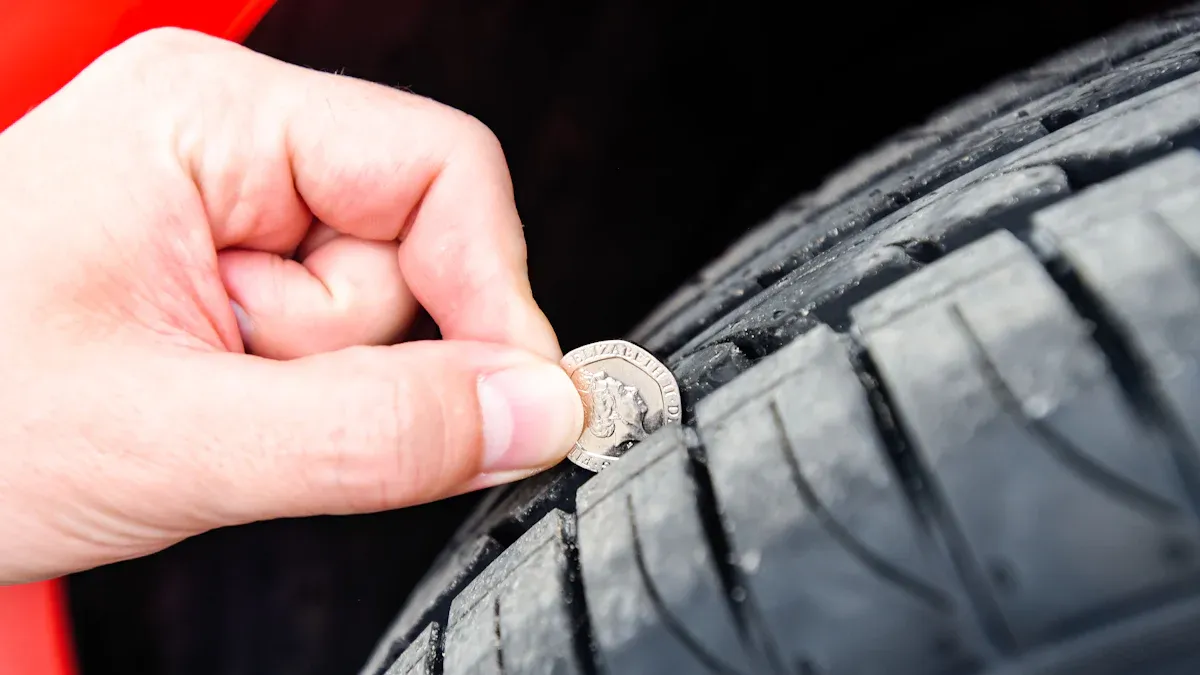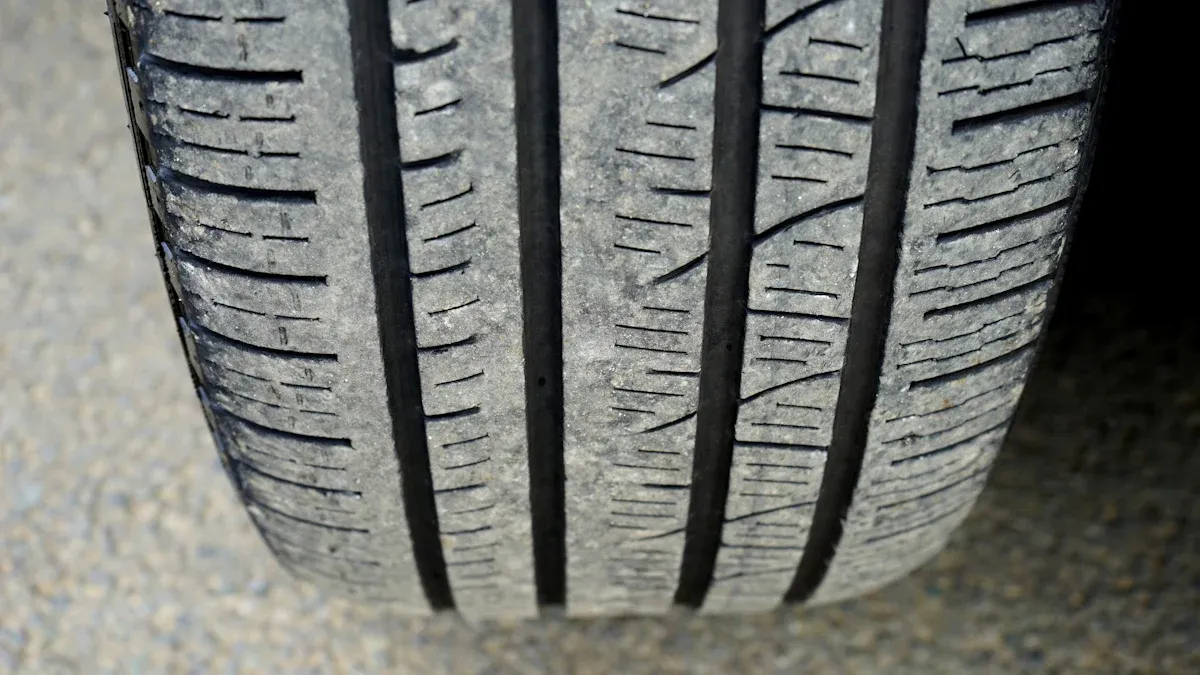
Measuring tire tread depth is essential for your safety on the road. Adequate tread depth helps maintain traction, especially in wet conditions. Insufficient tread can lead to dangerous situations. In fact, around 22.4% of vehicle accidents involve tire blowouts, often caused by worn tread. You can accurately measure tire wear using several methods, including the penny test, tread depth gauges, and built-in tire wear indicators. Each method provides a simple way to ensure your tires are safe for driving.
Key Takeaways
Adequate tire tread depth improves traction and reduces the risk of hydroplaning and accidents.
The legal minimum tread depth is usually 2/32 inch, but replacing tires at 4/32 inch offers better safety.
Use simple methods like the penny test or a tread depth gauge to check your tire tread regularly.
Regular tire inspections, proper inflation, and rotating tires help maintain tread depth and extend tire life.
Monitoring tread depth and wear bars ensures timely tire replacement and safer driving conditions.
Importance of Tread Depth
Tread depth plays a vital role in your vehicle’s safety and performance. Adequate tread depth ensures that your tires maintain proper traction, especially in wet or slippery conditions. When you drive on worn tires, you increase the risk of hydroplaning, which occurs when water builds up between the tire and the road. This can lead to loss of control and longer stopping distances.
Safety Implications
Traction and Grip: Deeper treads channel water away from the tire surface, improving grip on wet roads. This is crucial for maintaining control during sudden stops or sharp turns.
Stopping Distance: Studies show that worn tires can significantly increase stopping distances. For instance, at a speed of 60 mph, a vehicle with only 2/32 inch of tread may require an additional 122 feet to stop compared to one with new tires. This increase in stopping distance can be critical in avoiding accidents.
Wet Stopping Distance at 60 mph (feet) | Increase Compared to New Tires (%) | |
|---|---|---|
10 (new) | 234 | 0 |
4 | 282 | 20.5 |
2 (legal minimum) | 356 | 52.1 |
Legal Standards
Different countries have established legal minimum tread depth requirements to ensure safety on the roads. Here are some key standards:
Country | Vehicle Type | Minimum Legal Tread Depth |
|---|---|---|
United Kingdom | Cars, Light Vans, Light Trailers | 1.6 mm across central 3/4 of tread breadth and entire circumference |
United Kingdom | Motorcycles, Large Vehicles, Passenger Vehicles | 1.0 mm minimum tread depth |
United States | N/A | N/A |
Germany | N/A | N/A |
In the United States, the legal minimum tread depth is generally set at 2/32 inch. However, many experts recommend replacing tires when they reach 4/32 inch to maintain optimal safety. Driving on tires below the legal minimum can lead to fines and increased risk of accidents.
Regularly measuring tire wear is essential to ensure your tires remain safe and effective. By keeping an eye on tread depth, you can avoid dangerous situations and enhance your vehicle’s performance.
Measuring Tire Tread

Measuring tire tread accurately is crucial for maintaining safety on the road. You can use several methods to assess tread depth, each with its advantages and limitations. Here, we will explore three popular methods: using a tread depth gauge, the penny test, and visual indicators.
Using a Tread Depth Gauge
A tread depth gauge is one of the most accurate tools for measuring tire tread. It provides precise readings, allowing you to monitor wear effectively. Follow these steps to use a tread depth gauge:
Zero out the tread depth gauge by pushing it against a flat surface until the measuring pin fully retracts and the gauge reads 0/32.
Insert the measuring pin into the center of the tire’s main tread groove and gently push down until the base rests on the tread.
Remove the gauge carefully, holding the barrel to avoid moving the measuring pin, and note the measurement.
Repeat the measurement process at least two more times at different points about 15 inches apart to account for uneven wear.
Average the three readings by adding them together and dividing by three.
Using a tread depth gauge offers high accuracy, with a precision of 0.01 mm. This method serves as a reliable standard compared to other measurement techniques. For instance, machine vision systems may have a small absolute error of less than 0.2 mm, but they do not match the gauge’s precision.
Measurement Aspect | Tread Depth Gauge Precision | Machine Vision Absolute Error | Machine Vision Percentage Error | Stereo Vision System Error |
|---|---|---|---|---|
Precision/Accuracy | 0.01 mm | < 0.2 mm | 0.41% to 2.47% | Up to 1 mm |
Measurement Reliability | Used as reference standard | Comparable accuracy | Acceptable for automatic use | Higher error than gauge |
Measurement Method | Manual gauge measurement | Automated image processing | Automatic groove identification | Groove identification only |
Penny Test Method
The penny test is a simple and accessible way to check if your tire tread has reached the legal minimum of 2/32 inches. To perform this test, insert a penny into the tread with Lincoln’s head facing down. If you can see the entire head, your tread is at or below the legal limit, indicating the need for replacement.
While convenient, the penny test has limitations. It does not account for performance in adverse weather conditions. Tests show that tires with tread less than 4/32 inches perform poorly in hydroplaning resistance and snow traction. Therefore, using a quarter instead of a penny provides a better safety margin, as it measures about 4/32 inches of tread depth.
Visual Indicators
Visual indicators, such as tread wear indicators, offer a quick way to check if your tread depth is near the legal limit. These indicators are small raised areas in the grooves of the tire. When the tread surface aligns with these indicators, it signals that the tread is worn down.
However, visual checks are less precise than physical measurement tools. A tread depth gauge provides accurate measurements in millimeters. To ensure accuracy, take measurements around the tire’s circumference and across most of its width. A reading above 1.6 mm indicates safe tread depth.
To improve the accuracy of your measurements, consider these practical tips:
Measure tread depth at multiple points across the tire tread instead of a single spot to get a more accurate average.
Use digital or AI-enabled tread depth gauges that can measure thousands of points quickly, reducing human error.
Regularly inspect tires and record measurements to monitor wear patterns and predict tire life.
By employing these methods and tips, you can effectively measure tire wear and ensure your safety on the road.
Interpreting Tread Depth

Safe Tread Depth Levels
Understanding safe tread depth levels is crucial for your safety on the road. Tire tread depth is measured in 32nds of an inch. New tires typically range from 7/32 to 14/32 inches, depending on the type. The legal minimum tread depth in the U.S. is 2/32 inches. However, many experts recommend replacing tires when they reach 3/32 or even 4/32 inches. This recommendation helps maintain optimal safety, especially in wet or snowy conditions.
To assess your tire tread depth, follow these steps:
Place a penny with Lincoln’s head upside down between two ribs on your tire.
Check various points around the tire to detect uneven wear.
If the tread covers part of Lincoln’s head, your tread depth is sufficient for safety.
If you can see the entire head, your tread is worn to 1/16 inch or less, indicating it’s time to replace the tires.
Low tread depth increases stopping distances and reduces traction in adverse conditions. Testing shows that tires at the legal minimum require significantly longer stopping distances compared to those with deeper tread. For this reason, replacing tires when tread depth reaches about 4/32 inches is advisable for better safety.
Wear Bars and Indicators
Wear bars serve as helpful indicators for tire replacement. These small raised bars are embedded within the grooves of tire treads. They provide a visual indication of remaining tread depth. When the tread wears down to the level of these bars, it signals that the tire has reached the legal minimum tread depth, typically 2/32 inches. At this point, you should replace the tires to maintain safety and performance.
Regularly checking wear bars can help you assess evenness of wear. Here are some key points about wear bars:
They are placed around the tire to measure how evenly the tread is worn.
When tread wears down to the wear bars, tires are hazardous and should be replaced.
Checking wear bars by running a finger over them can help determine if tread is worn evenly.
By understanding safe tread depth levels and monitoring wear bars, you can ensure your tires remain safe, especially on wet or slippery roads. Regular inspections and timely replacements will enhance your vehicle’s performance and your safety.
Tire Maintenance Tips
Maintaining your tires is essential for safety and performance. Regular tire maintenance can extend the life of your tires and improve your vehicle’s handling. Here are some key tips to help you keep your tires in top shape.
Regular Inspections
You should inspect your tires at least once a month. Regular checks help you identify issues like tread wear, sidewall damage, and punctures before they lead to serious problems. Here are some inspection tips:
Check Tread Depth: Use the penny test or a tread depth gauge to measure tire wear. This ensures your tires have enough tread for safe driving.
Look for Damage: Examine the sidewalls for cuts, bulges, or cracks. These can indicate a potential blowout.
Monitor Pressure: Check tire pressure monthly. Proper inflation helps prevent uneven wear and improves fuel efficiency.
Regular inspections can significantly reduce the risk of tire-related accidents. They help you maintain traction and avoid blowouts, enhancing overall safety on the road.
Proper Tire Inflation
Keeping your tires properly inflated is crucial. Underinflated tires wear out faster and can lead to dangerous blowouts. Here’s how to maintain proper tire pressure:
Check Monthly: Use a reliable gauge to measure tire pressure at least once a month. Adjust the pressure according to the manufacturer’s recommendations.
Before Long Trips: Always check tire pressure before embarking on long journeys. Changes in temperature can affect inflation levels.
Avoid Overinflation: Overinflated tires can wear unevenly and reduce traction. Ensure you follow the recommended pressure guidelines.
Proper tire inflation not only extends tread life but also enhances your vehicle’s handling and fuel efficiency.
Rotating Tires
Rotating your tires is essential for promoting even tread wear. You should rotate your tires every 5,000 to 7,500 miles. Here’s why it matters:
Even Wear: Different tires wear at different rates based on their position on the vehicle. Rotating them helps distribute wear evenly.
Improved Traction: Evenly worn tires provide better grip on the road, especially in adverse weather conditions.
Extended Lifespan: Regular rotations can help you get the most out of your tires, saving you money in the long run.
Consult your vehicle’s manual for specific rotation patterns and intervals.
By following these tire maintenance tips, you can ensure your tires remain safe and effective. Regular inspections, proper inflation, and timely rotations will help you measure tire wear accurately and extend the life of your tires.
Regularly checking your tire tread depth is crucial for your safety and vehicle performance. Here are the key takeaways:
Legal minimum tread depths exist, commonly set at 2/32 inches. Driving below this limit can lead to fines and increased tire failure risk.
Use methods like the penny test or tread depth gauges to measure tread depth accurately.
By prioritizing these practices, you enhance your safety on the road and improve your vehicle’s overall performance. 🚗💨
FAQ
What is the ideal tread depth for safety?
For optimal safety, you should replace tires when tread depth reaches 4/32 inches. This depth helps maintain traction in wet conditions and reduces stopping distances.
How often should I check my tire tread depth?
You should check your tire tread depth at least once a month. Regular checks help you identify wear and ensure your tires remain safe for driving.
Can I use a ruler to measure tread depth?
Yes, you can use a ruler to measure tread depth. Place it in the tread grooves and measure from the base to the top of the tread. However, a tread depth gauge provides more accurate readings.
What happens if my tread depth is too low?
Low tread depth increases the risk of hydroplaning and extends stopping distances. Driving on worn tires can lead to accidents and may result in fines for violating legal tread depth limits.
How do I know when to replace my tires?
You should replace your tires when tread depth reaches 4/32 inches or when wear bars become level with the tread surface. Regular inspections will help you monitor tire condition effectively.
See Also
Step-By-Step Guide To Measuring Tire Tread Depth Precisely
The Importance Of Regular Tire Tread Checks For Safety
Understanding Smart Tire Tread Detectors And Their Functionality






